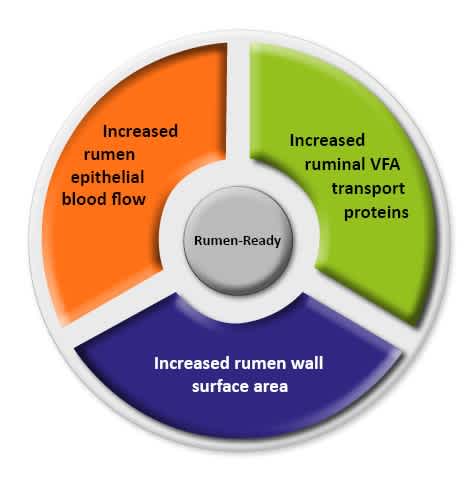The science behind Rumen-Ready ®

VFA drive rumen (re)development
The dry period of dairy cows is typically low in easily fermentable carbohydrates, which decreases the ruminal production of volatile fatty acids (VFA). As a consequence, the size of rumen papillae decreases during the dry period by more than 50%. This increases again following the switch to the lactation diet after calving. However, this increase is slow, and maximum rumen papillae redevelopment is observed at 50–60 days after calving. As studies support the assumption that the extent of VFA absorption is determined by the available rumen wall surface area, the effective absorption of VFA correlates with the number and size of papillae. This means that during early lactation there is a substantial delay in ruminal absorption of VFA, as well as other nutrients. This has negative consequences for the animal in terms of health and performance.

Figure 1: Butyrate stimulates rumen development
Butyrate is the most potent VFA
Butyrate is one of the VFA that is naturally produced in the rumen, although it is one of the more minor VFA produced. Feeding butyrate to dairy cows during the dry period increases rumen papillae length, rumen papillae thickness and rumen wall surface area. This is because butyrate is the most effective VFA at increasing rumen papillae length. Butyrate is unique because it stimulates the epithelial cell proliferation as well as specifically inhibiting cell death. Butyrate also increases the amount of VFA transport protein in the rumen wall tissue, which facilitates increased VFA uptake. Most of the absorbed VFA are removed from the rumen tissue by the blood, and butyric acid works by increasing ruminal tissue blood flow. Combined this means that feeding Rumen-Ready® prior to calving results in earlier rumen redevelopment ahead of lactation (Figure 1).
Bioavailable magnesium
As well as stimulating rumen redevelopment, Rumen-Ready® is also a highly bioavailable source of magnesium for dairy cows. Unlike magnesium oxide, 100% of the magnesium from Rumen-Ready® is soluble in the rumen, which is the main site of magnesium uptake in ruminants. Magnesium absorption in the rumen is also enhanced by butyric acid, due to it stimulating magnesium uptake. This is particularly important ahead of lactation due to the role magnesium plays in calcium metabolism.
Colostrum boost
The end of the dry period not only marks the start of lactation, but also the birth of a calf. Butyric acid is known in monogastric mammals to improve colostrum quality due to increased antibody concentrations. Field trials have shown that Rumen-Ready® also increases colostrum quality as well as quantity. Colostrum is key not only for the nutrition and health of newborn calves but also their future performance.
In summary, Rumen-Ready® is a leading and scientifically validated butyrate concept for mature ruminants developed by Palital. Rumen-Ready® is supported by established science and with proven results in the field.